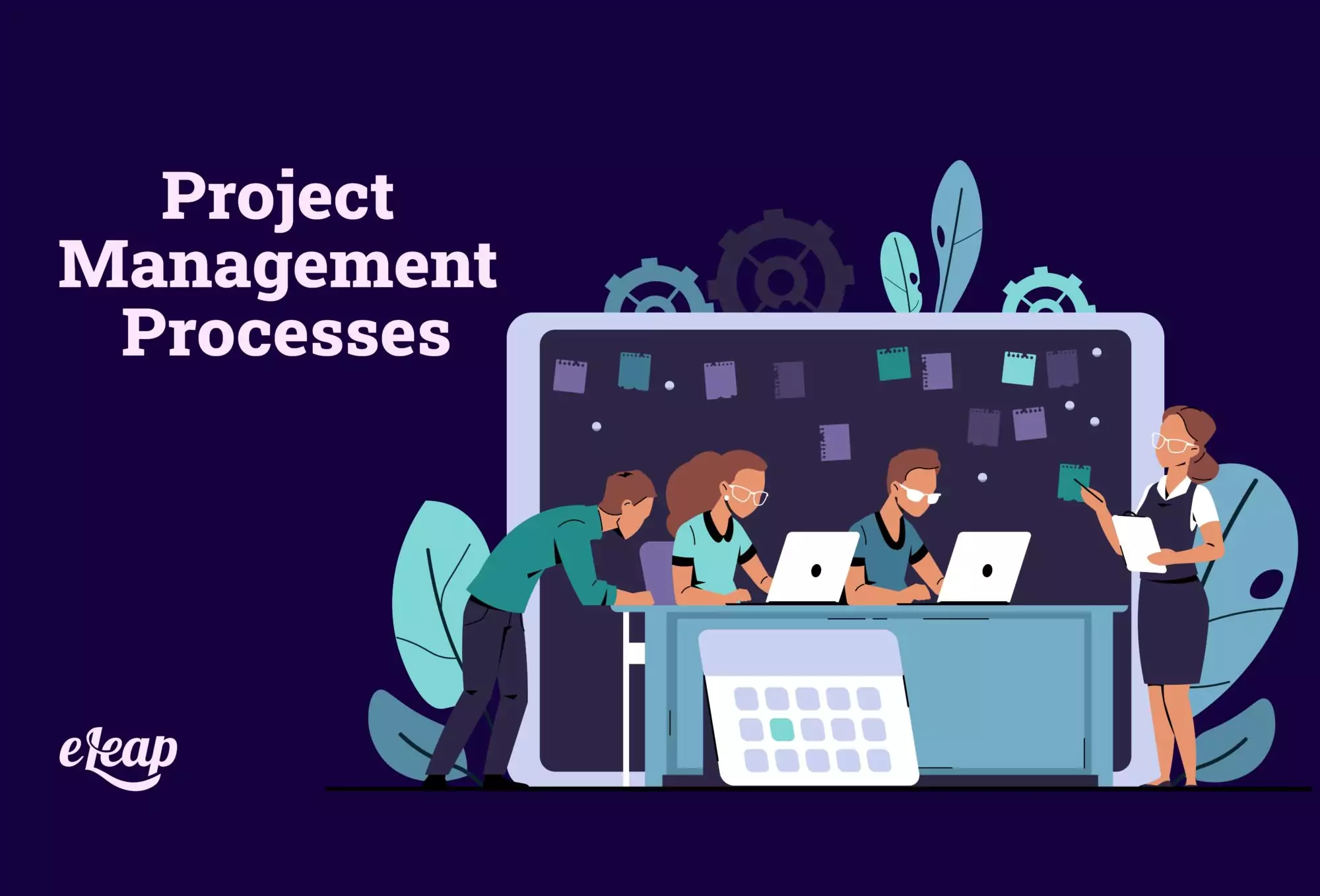Project Management Processes
Which project management processes work best?

When you’re starting a business or just attempting to make a new product in an existing business, you may not know where to start. Prepping and ensuring that your personnel is capable of performing the tasks is crucial before you start any new project. Getting together all your materials, setting up a workflow, and knowing your company goals are all necessary steps to production. But it can be challenging trying to keep track of all the moving parts of a business when you’re a manager or business owner. How do you ensure that your organization is prepared to effectively produce your project or service?

All your questions can be answered by implementing project management processes.
What Are Project Management Processes?
Project management processes are how businesses organize themselves to ensure that all elements of production lead to an economical outcome. These processes help to ensure that all the necessary skills needed for production are taught to workers. It also ensures that everyone is supplied with sufficient tools. Not to mention project management makes certain that all knowledge is communicated successfully across departments.
This means that project management processes are in charge of every element of production. From the gathering of resources to obtaining customer feedback, it should all be managed. This is done to improve quality, customer satisfaction, and to ensure that all-time goals are met. Processes make the backbone of your company. Project management processes help simplify the complex coordination of production components by giving structure to each department for more efficient outcomes.
What Are the Benefits of Implementing Project Management Processes?
It doesn’t matter if you’re a construction company, a pet-groomer, a chief, or a non-profit organization… project management processes can help you improve all aspects of your business from product quality to customer service.
Project management processes can help your business work smarter. When you’re getting each step of production done more efficiently, you’ll be saving money and time. Plus, when your business is more efficient and thoughtful, this leads to better delivery and a higher quality product. Well-delivered, high-quality products increase customer satisfaction. Satisfied customers are often repeat customers, and they will tell their friends and family about your excellent service.
All of these benefits ensure that your company begins to stand out amongst the competition, attracting even more customers.
Putting aside the bottom line, project management processes help your team become stronger. With better training and clear work systems developed by project management, your employees will better understand their tasks. Internal communication is often helped by project management, and better communication means your teams will work together more successfully. Outlining and identifying each step in the process of production can also help you, as an owner or manager, understand company risks. When you understand the possible risks in your business you can do more to prevent them. This can also help you fix current issues.
The final benefit of using project management processes is predictability. When you understand how your production works, the system becomes easier to reproduce. As your company reputation increases over time, you can begin effectively expanding your services. With better customer service, you’ll better anticipate customer demand, and facilitate new products to be positively received by the market.
Defining the Project
Before we delve into the processes of the project life, let’s first understand what a project is. There are many processes in a business, some of which are always ongoing or need continuous development. A project is not an endless process.
A project is defined by two major elements. One, a project is made up of a series of tasks. These tasks are meant to complete a specific outcome. Two, the project must be completed in a certain amount of time. At some point, the project should have a deliverable good or service, and be considered complete.
Now that the project has been defined, read on to explore the project life cycle.
The Project Life Cycle
There are five stages in a project’s life cycle that each project experiences.
The project management process helps your business work through each phase effectively. This ensures effective production. The five phases are defined as inception, scheduling, execution, monitoring, and closure.
Stage 1: Inception of the Idea
Project inception is the initial point of any project, and really for any business. This is the starting phase where the project manager has to prove to executives and shareholders that the presented project will provide value to the company. Any project your company attempts needs to not only theoretically bring value to your business, but it also must be feasibly completed. Feasibility includes the initial investment taken to start the project, the workers it will take to complete it, the time it will take, and the overall cost.
In this stage, several documents will need to be created. To prove feasibility, your project manager will complete a feasibility study. This will prove that your new project is feasible and that you won’t waste money and time pursuing an endlessly expensive project.
The next document you’ll need to complete is the project charter. A project charter is a document that you’ll use to describe the project. This document explains to the business and all necessary personnel the value of this project. That includes what this project is going to deliver, why your organization needs this project, how it will benefit the business, and any profits that may be gained by pursuing this project.
If this project proposal gets rejected, as many do, it may never leave this stage. However, if you or your project manager are sure that this can give value to the company, go back to the drawing board. Re-schedule, re-phrase, or simplify your project and attempt to persuade the necessary people again.
The inception stage ends with a meeting that gets the management, the team, stakeholders/shareholders, and whoever else needs to be informed of the new project together. This meeting will ensure that everyone understands the goals of the project. It also establishes the timetable and the chain of command.
Stage 2: Scheduling and Planning
Once your project has moved past the initiation phase and been permitted, it enters into the second stage of the project life cycle. This is where you do all the scheduling and planning for project execution. Every component of execution should be analyzed and understood. Then put each component into a series of processes that will be used to make sure that your project can complete the goals you argued for in stage one.
Break down the project into smaller sections that help create milestones for employees to work towards and help keep your project on schedule. This is also where you will create and assign roles for employees. Making a visual chart can help everyone understand the path to project completion and provide an easily referenced project guide.
Stage 3: Execution of Plans
After you’ve gotten your project approved and you’ve created a plan that leads to successful project completion, you can begin executing your processes. Actual work is done in this stage and success here is reliant on strong leadership. A good manager will make sure that execution sticks to the plans made in stage two. This is done by making sure that the team or teams working on your project stay on schedule, and that communication issues and unforeseen problems that may halt production are effectively mediated.
Stage 4: Monitoring and Control
Stage four, monitoring and control, goes hand in hand with stage three. This part of the project life cycle is about ensuring the final goal defined in stage one is actualized by the execution phase. This is where budget and time are constantly monitored to ensure the team is not off schedule and that the project remains a valuable asset. This stage also helps ensure that the project isn’t steadily growing in scope over time. A project may discover a new issue that your company should address, but that issue should be considered further and developed into a new project instead of adding it to an ongoing one.
Stage 5: Project Closure
This is the final stage of a project. All execution and quality assurance has been done in the previous stages. Now the project is completely finished. In this time, you can look back on the project and analyze the process. See what worked and what didn’t, and learn how you can apply unexpected knowledge to the rest of your business for new innovations.
Using Project Management Processes in Your Business
You may be struggling to make your business more efficient, and it can be difficult to know where to start when there are so many processes to consider. By implementing project management processes, you can increase your efficiency while also improving the quality of your product. Understanding the five stages of a project’s life cycle can help you identify areas in your production that aren’t working as effectively as they could be. Save money and time–and build a better workforce – by implementing these processes into your business.